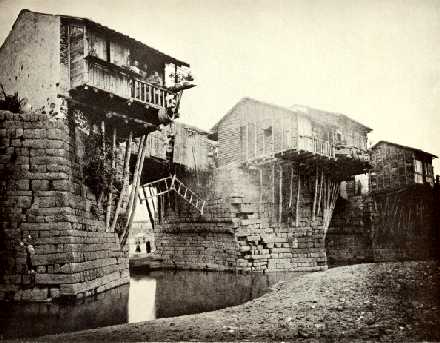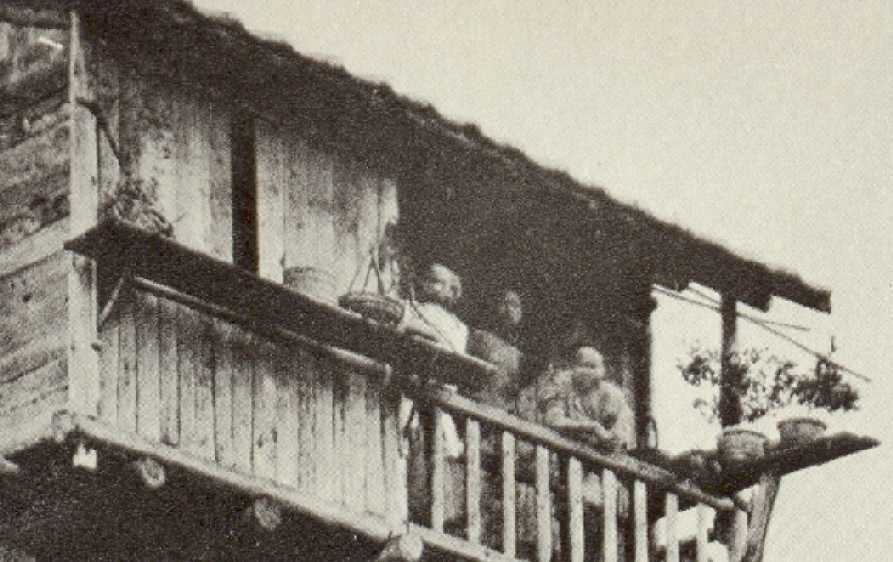


Detail of upper left quadrant. Is the specimen just left of center here an exposed root cascade?
|
|
A
|
|
A
|
|
|
|
A
|
A
|
|
Currently, the oldest-known
photograph from China which includes dwarf potted trees is c.1868,
"Bridge over Han River at Ch'ao-Chou, Fukien [Chao'an, Fujian]" by John
Thomson (1837-1921). One of the greatest photographers of the
nineteenth century, Thomson's powerful, subtle and innovative work is
less known but was often decades ahead of its time. He was the
first photographer to document many of the people and images of the Far
East, producing or illustrating at least fourteen books (a few in very
limited editions), over two dozen articles, three translations, and
giving lectures at the Royal Geographical Society and other
bodies. As a young man, this Edinburgh native had some reputation
as a photographer of architecture. Ambitious for the period, he
later was based in Singapore from 1863-64, visited Ceylon and India
in 1864, travelled to Siam, Cambodia and Vietnam during 1865-66 and
1867-68, settled and travelled in South China between 1868 and 1872,
visiting North China in 1871. By his own estimate he travelled
between four and five thousand miles in China. He finally based
himself in London, where he documented the slums. A final visit
to Cyprus took place in 1878. Half of Thomson's 1200 numbered
glass plate negatives are preserved in London.
Chao'an lies halfway between Hong Kong and Amoy in southeast China, and is about thirty kilometers inland. At least four potted trees are seen on the balcony of the leftmost house built off of the bridge (see detail above). At least one more is on the balcony of the house just to the right of center. "This bridge over the river Han at Chaochow is perhaps one of the most remarkable in China. Like old London Bridge...it affords space for one of the city markets... While taking the illustration, I endeavored to avoid the crowd by starting to work at daybreak, but the people were astir, and seeing my strange instrument pointed cannonwise towards their shaky dwellings, they at once decided I was practising some outlandish witchcraft against the old bridge and its inhabitants. The market stalls were abandoned, that the barbarian who had come to brew mischief for them might be properly pelted. The roughs and the market people came heart and soul to the task, armed with mud and missiles, which were very soon flying in a shower above my head. I made a plunge for the boat and once on board, it told to my advantage when I charged a ruffian with the pointed tripod as he attempted a black eye of mud in exchange. For myself I sustained but little damage, while it may fairly be said that the bridge was taken at the point of the tripod." 1 In 1898 was published his work Through China With a Camera, which contains the following excerpts: "The Fatee gardens, so often described were still to be found, almost unchanged, at the side of a narrow creek on the right bank of the river. These gardens were nurseries for flowers, dwarf shrubs and trees. Like most Chinese gardens they covered only a small area, and were contrived to represent landscape gardening in miniature..." (pg. 54); and "...[perhaps the most interesting temple in Canton is the Temple of 500 Gods...] The abbott... received us with great cordiality, and showed us into his private apartments, where we enjoyed a repast of tea and cake, and spent some time in examining a collection of dwarf trees and flowering shrubs, which he had arranged in a court in front of his sitting-room. In the centre of this court stood a tank containing fish, and a group of sacred lotus flowers in full bloom. The old gentleman had spent many years of his life in seclusion and seemed to be devoted to his garden, expressing his delight to find a foreigner who could share in his love of flowers." (pg. 80). 2 |
|
1
Goodrich, L. Carrington and Nigel Cameron
The Face of China As Seen by Photographs & Travelers, 1860-1912
; (New York: Aperture, Inc.; 1978), photo on pg. 61, bridge quote from pg.
152, and pp. 152-153. Note: The height and breadth of the plants
compared to that of the containers was a key determinant for RJB
choosing this photo. Other potted plants seen in photographs from
1865 to 1878 had too thin a trunk and branch structure to be considered
as dwarf potted trees. Cf. pp. 47, 62, 95, or 108.
There are possibly other less distinct trees on the railing of the
house to the right of center of the main photograph.
White, Stephen
John Thomson, A Window to the Orient
; (New York: Thames and Hudson, Inc.; 1985) First edition 1986, pp.
7-44. The "Bridge over Han River at Ch'ao-Chou, Fukien"
photograph is not included here.
Note: Titley, Norah and Frances Wood
Oriental Gardens, An Illustrated History
(San Francisco: Chronicle Books; 1991), pg. 124 state that "One of Thomson's photographs
(c.1865-66) is of a group of Singapore Chinese merchants who lounge beside
tables covered in porcelain pots in which grasses, flowering shrubs and foliage plants
grow; behind these there appears to be a 'pot scene' [
pen jing
] with a group of gnarled timbers." That particular photograph has not yet been
found by RJB.
2
Thomson, John
Through
China With a Camera (Westminster: A Constable & Co.; 1898). A darker copy of
the above photo can be found before pg.
91,
with the above description two pages later. The Singapore Chinese merchants photo is not to be found here; however,
an undated photo of a building with what might also be second-storey trees -- though much less distinct -- in the upper right can be found before pg.
33,
and possibly a dwarf potted tree left of photo center might be seen before pg.
59.
Several of the photos in Goodrich and White's books are found in this work also.
|